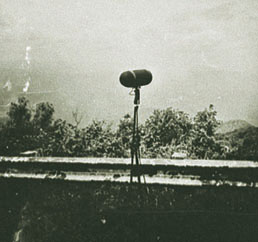 SOUNDTRACK: JERUSALEM IN MY HEART-Mo7it Al-Mo7it [CST093] (2013)
SOUNDTRACK: JERUSALEM IN MY HEART-Mo7it Al-Mo7it [CST093] (2013)
 So just what is Jerusalem in My Heart? According to the Constellation records website:
So just what is Jerusalem in My Heart? According to the Constellation records website:
Jerusalem In My Heart (JIMH) has been a live audio-visual happening since 2005, with Montréal-based producer and musician Radwan Ghazi Moumneh at its core. Moumneh is a Lebanese national who has spent a large part of his adult life in Canada. Moumneh is also active in the Beirut and Lebanese experimental music scenes, where he spends a few months every year.
but more specifically, what does it sound like?
Jerusalem In My Heart (JIMH) is a project of contemporary Arabic and electronic music interwoven with 16mm film projections and light-based (de)constructions of space, exploring a relationship between music, visuals, projections and audience. … [The album blends] melismatic singing in classic Arabic styles and electronic compositions with contemporary electronic production. … Moumneh’s voice has become a powerfully authentic instrument, [along with Saturated synths and the overdriven signals of Moumneh’s acoustic buzuk and zurna].
And what’s up with the title of the record?
The numeral 7 is pronounced like an h; all titles on the album are rendered in contemporary colloquial “mobile” Arabic (the transliterative characters used in Arabic phone texting).
Alright, now that that’s out of the way, the album begins with “Koll lil-mali7ati fi al-khimar al-aswadi (Speak of the Woman in the Black Robe)” which opens with an echoed voice that reminds me of the way a dance track might start. But it quickly becomes clear that the singer is sing in Arabic and in a somewhat traditional manner (but with an echoed effect on the voice). I don’t really know how Arabic music might be sung, but this is what it sounds like to me. By the end of the track, some keyboards are added, echoing to the end.
The second track, “3andalib al-furat (Nightingale of the Euphrates)” is a 9-minute instrumental. It opened with acoustic stringed instruments Dina Cindric playing the Rast Virginal on the banks of Al-Furat. It is a beautiful piece, recorded outdoors with the sounds of birds and other animals contributing. It never grows louder than these instruments.
And then this acoustic and mellow piece jumps into the very electronic sounding third song, “Yudaghdegh al-ra3ey wala al-ghanam (He titillates the shepherd, but not the sheep…).” The opening riff is very late 70s Tangerine Dream-sounding. I expected a lengthy instrumental, so I was very surprised when the female vocalist (I assume Malena Szlam Salazar) began singing in tradition Arabic style. It’s a great mix. Especially at the end as her voice gets more processed.
Track four, “3anzah jarbanah (Sick, Diseased Goat)” is a mostly a capella vocal song with Moumneh singing in his mournful keening voice. He sounds pained as his voice has a slight echo to it. After about three minutes a distorted keyboard plays behind the voice. It has a distinctly 1980s sci-fi vibe.
“Ya dam3et el-ein 3 (Oh Tear of the Eye 3)” is 5 minute-instrumental which I believe is done mostly by Sarah Pagé playing the Bayat Harp on the banks of Dajla. Again birds are heard throughout. These instrumentals are just lovely.
“Ko7l el-ein, 3oumian el-ein (Eyeliner of the Eye, Blindness of the Eye)” has a kind of solo opening on what I assume is the buzuk. It’s fast and a little wild by the end with an electronic sounding synth line running in the background that more or less takes over the song. The final track is ” Amanem (Amanem)” which has Moumneh’s vocals and a keyboard drone behind it. It’s a rather mournful and spooky vocal style and sounds likes he as about to cry.
Since I don’t really know what the album is about, the ending seems like kind of a downer. But since I am exposed to practically no contemporary Arabic music, I found this to be a really interesting listen, and I wonder if it is in any way representative of contemporary Arabic music.
[READ: August 22, 2016] “My Holy Land Vacation”
I read this more of Bissell, not because of the contents, as I like Bissell quite a bit. But I found myself strangely engrossed by this story of traveling to Israel with a busload of Conservatives.
Bissell says that he enjoys listening to right-wing radio. He names a few hosts who I don’t know and then ends with Dennis Prager. I don’t know him either, but he is the impetus for this article so there ya go. Bissell describes him as the “patriarch trying to keep the conversation moderately high-minded” which sounds pretty good.
Prager is Jewish and his audience is largely Christian. And in the summer he organized a Stand with Israel tour. For about $5,000 you could go on an all-inclusive guided tour across the world’ holiest and most contested land.
Bissell provides some context that the religious right hasn’t always been fans of Israel. Indeed my recollection is that the Christian right was very antisemitic. But by 2002 conservatives were vested in the cause because of some common beliefs like forbidding abortion and being suspicious of Muslims.
When Bissell first saw Prager in person he admits to the man’s charisma. Bissell talks about what is known as the Israel Test which is summed up “if you ever find fault with Israel, you’re horrible.” Prager believes that all American parents should send their children to Israel between high school and college to let their moral compass be righted again.
As for the trip itself–the food is plentiful everywhere–embarrassingly so. He doesn’t like many of the people on the trip. And he and his wife have to remember to not act like New York liberals. But the one thing that Tom and his wife (and the people he has grown to like on the bus) can agree on is that their guide David is “the tour guide to have while Standing with Israel.”
Bissell is pleased to hear that the locals are pretty even-handed about a lot of things, always trying to explain up how most of the citizenry–both Israelis and Palestinians want peace. But the travelers are appalled at this even handedness. They want partisanship. A woman yells that there no way that Israelis are teaching their children to hate. A soldier–a man who lives here–responds to her that he knows Israeli families who do raise their children to hate Palestinians. She responds, “Respectfully, no. Respectfully, no.”
Later when they go to Nazareth, their tour guide explains that Nazareth has pretty much always been Arab territory–they didn’t take it from the Israelis, but no one appears satisfied with this answer.
Eventually they go to a settlement and meet self-described “Israeli rednecks.” The man was born in Cleveland and moved to Israel in 1961. He is a rabble-rouser and makes Bissell uncomfortable. Bissell has to leave the room during the man’s excoriations. When he steps outside, he meets Pastor Marty who is also appalled at the belligerence. Marty blames talk radio in general and wonders when the last time “anyone was forced to have a civil discussion with someone who thought differently.”
But the real crisis is aboard Bus Five–Bissell’s bus–because their beloved tour guide has been fired because of complaints. And a whole section talks about the bus’ reaction to this. They even form factions who want to Stand Up for Dave, and the de facto leader begins trying to find out who is for or against Dave. The section is pretty fun and strangely exciting.
But the final section grows much more serous. They visit Yad Vashem, Jerusalem’s Holocaust Memorial.
Soon the rest of the bus and its occupants are forgotten and Bissell simply thinks about this memorial and the thousands of dead. And then he thinks of his own family–he and his wife left their relatively new-born daughter home with grandparents.
I expected that this essay would be full of some crazy people spouting crazy things. And to an extent it was, but what I like about Bissell’s writing is how empathetic he is and how he can really convey different perspectives while retaining his own individuality. The essay also contained a lot of interesting information and had a surprisingly emotional ending–one that is far removed from right-wing radio..
Read Full Post »
 SOUNDTRACK: LAND LINES-Tiny Desk Concert #494 (December 11, 2015).
SOUNDTRACK: LAND LINES-Tiny Desk Concert #494 (December 11, 2015). Land Lines are a trio from Denver. They have a drummer, a synth player and a cellist/lead singer. Although their music is pretty spare and simple, I find them really compelling.
Land Lines are a trio from Denver. They have a drummer, a synth player and a cellist/lead singer. Although their music is pretty spare and simple, I find them really compelling.














